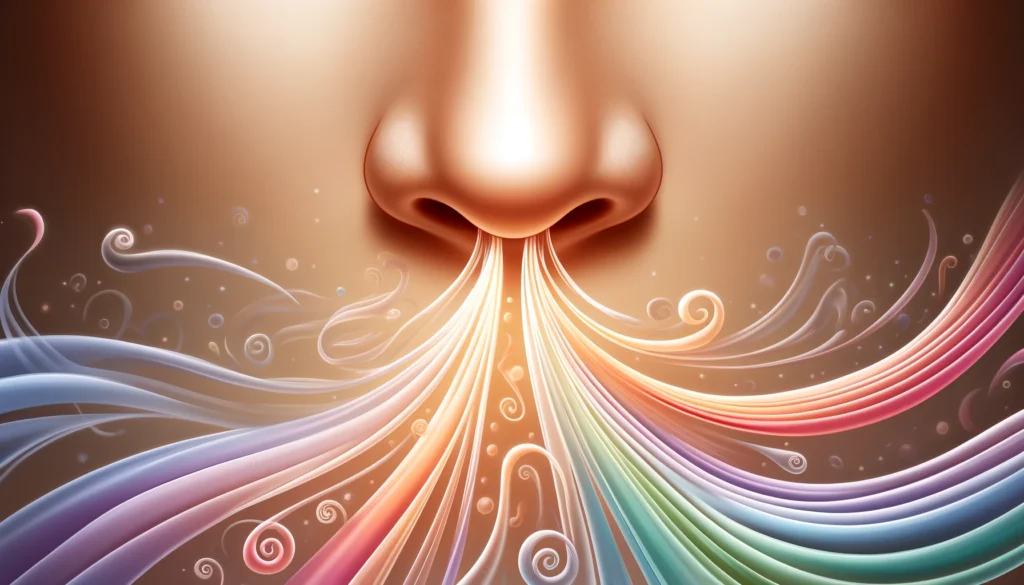
1. Introduction: Why Smell Is More Powerful Than You Think
The Smell is a silent architect of our experiences. It shapes how we feel, what we remember, and how we respond to the world around us. While often overshadowed by sight and sound, the power of smell plays a crucial role in health, emotions, safety, and even cultural identity.
2. Anatomy of the Nose: Gateway to Scents
The nose is more than a breathing tool—it’s a finely tuned chemical detector.
- The nasal cavity is lined with mucosa that helps dissolve odor molecules.
- At its roof lies the olfactory epithelium, home to millions of sensory neurons.
- These neurons connect to the olfactory bulb, the brain’s scent-processing center.
3. How the Olfactory System Works
Smelling is a complex process that happens in seconds:
- Odor molecules enter through the nostrils.
- They dissolve in the nasal mucosa and bind to specific olfactory receptors.
- These receptors send electrical signals to the brain.
- The brain decodes these signals into recognizable scents.
Each scent has a unique signature, like a fingerprint, processed across various brain areas.
4. The Journey of an Odor Molecule
- Odor molecules travel through air, guided by volatility (how easily they evaporate).
- Once inhaled, their journey depends on solubility, speed, and environmental conditions.
- This journey influences how intense or long-lasting a scent feels.
5. What Makes a Smell Pleasant or Unpleasant?
🧠 A. It All Starts in the Nose
Your nose contains olfactory receptors—specialized neurons in the olfactory epithelium (a tissue inside your nasal cavity).
- There are around 400 types of olfactory receptors in humans.
- Each receptor is tuned to recognize specific molecular shapes (odorants).
- When you inhale, these molecules bind to receptors like keys in locks.
📡 B. Signals Sent to the Olfactory Bulb
Once odor molecules activate receptors, they send electrical signals to the olfactory bulb at the base of the brain.
- The olfactory bulb organizes this input and identifies the odor “pattern.”
- It’s like recognizing a chord rather than individual notes.
🧬 C. The Brain Links Smells to Emotion and Memory
Here’s where it gets really interesting:
- The olfactory bulb connects directly to the amygdala (emotion) and hippocampus (memory).
- This is why smell is the only sense that bypasses the thalamus (brain’s relay center) and goes straight to the limbic system.
- Good or bad smell perception is shaped by past experiences, context, and emotion.
🍪 For example, the smell of cookies might make you feel warm and happy—if your brain associates it with your childhood home.
⚖️ D. How We Judge “Good” vs “Bad”
There’s both a biological and learned side to this:
🔬 Biological (Innate) Responses:
- Some smells are universally unpleasant (like rotting food, feces, smoke) because they signal danger or disease.
- These are often detected by special receptors linked to disgust responses.
🎓 Learned (Cultural + Personal) Responses:
- We also learn to love or hate smells based on:
- Culture (e.g., fermented fish may smell bad to one culture but delicious to another)
- Experience (e.g., perfume that reminds you of a bad breakup may seem repulsive)
🧠 E. Brain Areas Involved
- Insula – links smell to disgust (especially bad odors)
- Olfactory Bulb – initial processing
- Piriform Cortex – odor identification
- Amygdala – emotional reaction
- Orbitofrontal Cortex – conscious perception and judgment
6. Memory, Emotion, and the Power of Smell
It is directly linked to the brain’s memory and emotion centers—specifically the amygdala and hippocampus.
- One familiar scent can trigger vivid memories.
- Scents like lavender or vanilla can reduce stress.
- This strong connection is why aromatherapy is so effective.
7. Health and Safety Impacts of Smell
Smell protects and supports our health:
- Detects danger: gas leaks, smoke, spoiled food
- Supports appetite and nutrition
- Influences emotional health: mood, anxiety, attraction
Loss of smelling (anosmia) can reduce life quality and increase risks.
8. Disorders of Smell and Their Effects
Smelling disorders include:
- Anosmia: complete loss of smell
- Hyposmia: reduced sensitivity
- Parosmia: distorted smells
Causes range from viral infections to neurological diseases and aging. These conditions affect mental well-being, appetite, and personal safety.
9. Environment and Cultural Influences on Smell
- Pollution and smoking can dull smelling sensitivity.
- Humidity and temperature affect scent intensity.
- Culture shapes what’s considered a “pleasant” or “offensive” aroma.
For example, a spicy scent may be comforting in one culture and overwhelming in another.
10. Technological Advances in Smell Science
Modern tools like brain imaging and genetic mapping reveal how we process scents and how receptors are distributed in the nasal cavity.
Emerging applications include:
- Digital scent technology in VR
- Artificial noses for detecting diseases or gas leaks
- New treatments for olfactory disorders
11. Practical Tips to Enhance Your Sense of Smelling
You can boost your olfactory awareness through simple habits:
- ✅ Stay hydrated
- ✅ Avoid exposure to pollutants
- ✅ Practice with scent training (e.g., sniff essential oils daily)
- ✅ Eat a nutrient-rich diet that supports nerve health
12. Final Thoughts: Embracing the Olfactory World
Smell is more than a sense—it’s a gateway to emotion, memory, and survival. By understanding the power of smell, we can deepen our sensory experiences, enhance wellness, and even reconnect with the world around us in a more meaningful way.
13. Sources and Further Reading
- Harvard Gazette – The Science of Smell
- NIH – The Human Sense of Smell
- Scientific American – How We Smell






